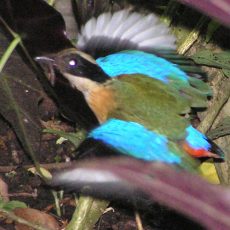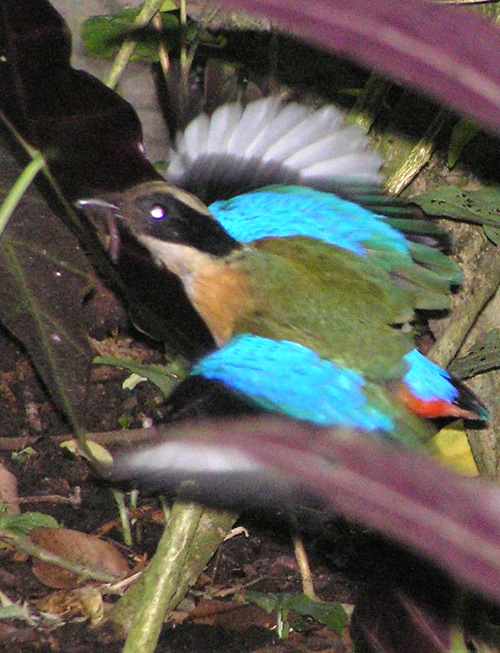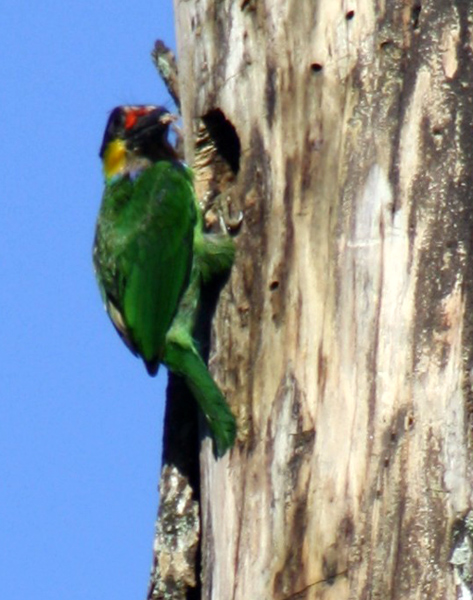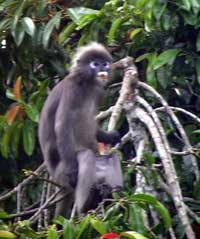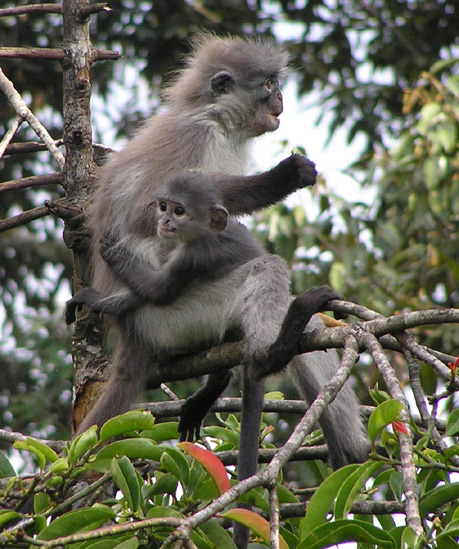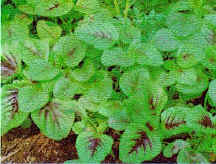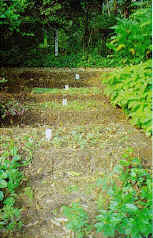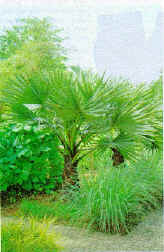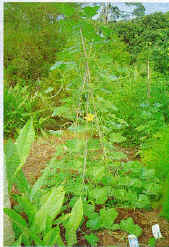by Angela Hijjas
From The Malaysian Naturalist, vol. 54 no. 2, 2000.
 As I have often noted in this column, Malaysian species are not known for colour, unless you are fortunate enough to see the huge Rafflesia in full bloom on the forest floor, or Bauhinia kockiana (left) enveloping a tree canopy on the other side of a valley. Most are more discrete in their display and the naturalist gardener has to find satisfaction in other detail of form and habit.
As I have often noted in this column, Malaysian species are not known for colour, unless you are fortunate enough to see the huge Rafflesia in full bloom on the forest floor, or Bauhinia kockiana (left) enveloping a tree canopy on the other side of a valley. Most are more discrete in their display and the naturalist gardener has to find satisfaction in other detail of form and habit.
However, in the attempt to convert as many as possible to the naturalist approach, it is worth noting that there are some remarkable coloured features that can be introduced to a garden that are also indigenous to the region.
Tall trees, like the perah, Elateriospermum tapos, have a wonderful red flush of new leaves that immediately identify it in the forest, as does the Pometia pinnata, or kasai, but few urban gardens have the space to plant such trees and to view this colour requires a separation of distance. Mertajam, Erioglossum rubiginosum, is a smaller tree that has ruby red berries that develop after the creamy pannicle of tiny blossoms. The leaf shafts of the so-called sealing wax palm, Cytostachus renda, create beautiful columns of scarlet and a strong vertical rhythm for a planting arrangement thus providing a double contrast.
 A very successful and colourful climber is the Congea velutina (left), with its pink orchid-like sprays that provide a mass of colour which actually comes from the flower bract, as the flower itself is visually insignificant. Its scrambling habit requires something sturdy to climb on and should you be tempted to cut it back, it will not flower for another year until it has developed sufficient mass to cover a whole tree. I have sacrificed a Filicium decipiens to this creeper and fear that underneath, the poor tree has quietly died, discretely taking care of a non-indigenous whim planted in the early days! I have seen Congea flowering near a salt lick in the Ulu Muda forest reserve in Kedah, an experience I recall as I see the same plant in my garden. It makes an excellent cut flower, an added bonus when most tropical flowers rapidly wilt.
A very successful and colourful climber is the Congea velutina (left), with its pink orchid-like sprays that provide a mass of colour which actually comes from the flower bract, as the flower itself is visually insignificant. Its scrambling habit requires something sturdy to climb on and should you be tempted to cut it back, it will not flower for another year until it has developed sufficient mass to cover a whole tree. I have sacrificed a Filicium decipiens to this creeper and fear that underneath, the poor tree has quietly died, discretely taking care of a non-indigenous whim planted in the early days! I have seen Congea flowering near a salt lick in the Ulu Muda forest reserve in Kedah, an experience I recall as I see the same plant in my garden. It makes an excellent cut flower, an added bonus when most tropical flowers rapidly wilt.
 On a smaller scale, there seem to be many indigenous plants that provide purple to pink hues that can be combined to create a mixed planting to some effect. The smallest and easiest to grow must be the tiny ginger Kaempferia pulchra, which can be readily divided for a low ground cover and always has a fresh display of mauve flowers each morning. It does die back for a few months during the wet season, but it will come good again. This can be planted with the Persian shield, Strobilanthis dyeranus (pictured left, which I believe is indigenous to Burma), or combined with the silvery purple leaves of Hemigraphis alternata in dappled shade. A recent find is Pyllagathis rotundifolia, which I have seen growing by the waterfalls in Templer Park. The large round leaves are a feature in themselves, but there is a pretty cluster of tiny pink flowers that emerges at the centre. Cat’s whiskers, Orthosiphon stamineus, have a lilac form and it flowers well in fairly open positions. The common coconut orchid will grow in full sun and provides a constant supply of purple flowers if it is fed frequently with chicken dung, preferably composted so that it doesn’t smell.
On a smaller scale, there seem to be many indigenous plants that provide purple to pink hues that can be combined to create a mixed planting to some effect. The smallest and easiest to grow must be the tiny ginger Kaempferia pulchra, which can be readily divided for a low ground cover and always has a fresh display of mauve flowers each morning. It does die back for a few months during the wet season, but it will come good again. This can be planted with the Persian shield, Strobilanthis dyeranus (pictured left, which I believe is indigenous to Burma), or combined with the silvery purple leaves of Hemigraphis alternata in dappled shade. A recent find is Pyllagathis rotundifolia, which I have seen growing by the waterfalls in Templer Park. The large round leaves are a feature in themselves, but there is a pretty cluster of tiny pink flowers that emerges at the centre. Cat’s whiskers, Orthosiphon stamineus, have a lilac form and it flowers well in fairly open positions. The common coconut orchid will grow in full sun and provides a constant supply of purple flowers if it is fed frequently with chicken dung, preferably composted so that it doesn’t smell.
 The humble kantan, Etlingera elatior, makes a magnificent flower and splash of colour if left to open rather than cutting it for the laksa pot. There are many varieties ranging from the palest pink to scarlet and coral red. Other Zingibers, like the shell ginger, Alpinia latilabris, have short lived flowers but the orange fruit provides a more durable display.
The humble kantan, Etlingera elatior, makes a magnificent flower and splash of colour if left to open rather than cutting it for the laksa pot. There are many varieties ranging from the palest pink to scarlet and coral red. Other Zingibers, like the shell ginger, Alpinia latilabris, have short lived flowers but the orange fruit provides a more durable display.
Bananas come in a wide range of forms, many of which are very ornamental, pink, orange or purple, but not edible except by wildlife. The burgundy splattered leaves of Musa sumatrana provide an interesting foliage contrast. Musa bactris (below), a Sabahan, has a wonderful red flower whose ‘petals’ are edged in yellow, and another variety from Endau has white flowers and white fruits…. and there lies my problem, I get carried away with so many varieties and forget about colour, but white is a colour when you consider it against lush green foliage.
From the botanical point of view, the banana ‘flower’ that provides the coloured display, is once again the flower bract. As each one opens it first reveals the female or bisexual flowers that develop into the fruit. As more bracts fall away, rows of tiny male flowers are displayed well after the female flowers have developed into the fruit further back on the stem, so the plant cannot fertilize itself.
Other foliage contrast can be achieved using Pisonia alba, although I have had very mixed results planting this difficult species. It seems to like some protection and constant dampness. The yellow Pandanus also presents its share of problems but when established it provides a wonderful contrast, not just of colour but also of form.
 Leafing through the tropical gardening books at the wonderful pictures of lush gardens and planting arrangements, obviously I am not alone in finding it difficult to get enough colour to contrast against the mass of tropical green. Visual interest for the photographer is provided by coloured walls, the sparkle of water, the incredible range of plant forms providing artistic compositions, the inclusion of interesting pots and fountains, paving stones and of course the ubiquitous bougainvillea or heliconias, those foreign devils that are so tempting with their colourful splash of the exotic.
Leafing through the tropical gardening books at the wonderful pictures of lush gardens and planting arrangements, obviously I am not alone in finding it difficult to get enough colour to contrast against the mass of tropical green. Visual interest for the photographer is provided by coloured walls, the sparkle of water, the incredible range of plant forms providing artistic compositions, the inclusion of interesting pots and fountains, paving stones and of course the ubiquitous bougainvillea or heliconias, those foreign devils that are so tempting with their colourful splash of the exotic.
But if all else fails, a discrete piece of coloured sculpture may do the trick.







 Jasminum sambac, the popular jasmine (pictured above), ‘bunga melor’ or ‘melati’, was brought from India, and is a restrained creeper that likes full sun and support for climbing. A recent perfume success in my garden is the very robust vine Chonemorpha macrophylla (left), just two plants would be enough to take care of a tennis court fence, so it needs lots of space and a strong support to climb on. Another popular and fragrant climber that is not so invasive is the drunken sailor or Rangoon creeper, Quisqualis indica, whose drooping fragrant flowers are red in bud, appearing white when first opened, before aging to pink and crimson.
Jasminum sambac, the popular jasmine (pictured above), ‘bunga melor’ or ‘melati’, was brought from India, and is a restrained creeper that likes full sun and support for climbing. A recent perfume success in my garden is the very robust vine Chonemorpha macrophylla (left), just two plants would be enough to take care of a tennis court fence, so it needs lots of space and a strong support to climb on. Another popular and fragrant climber that is not so invasive is the drunken sailor or Rangoon creeper, Quisqualis indica, whose drooping fragrant flowers are red in bud, appearing white when first opened, before aging to pink and crimson.

 For a cut fragrant flower, nothing is quite as spectacular as the entire inflorescence of the common coconut, and it makes a beautiful sculpture laid on a table. This flower may well have been the original ‘bunga manggar’ (right), tied at the top of a bamboo pole and carried at the head of a bridal procession.
For a cut fragrant flower, nothing is quite as spectacular as the entire inflorescence of the common coconut, and it makes a beautiful sculpture laid on a table. This flower may well have been the original ‘bunga manggar’ (right), tied at the top of a bamboo pole and carried at the head of a bridal procession.
















